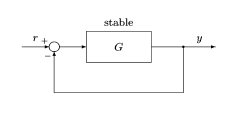
The basic structure of the code is emphasized in color; R/r means right (arrow/line), b means box, d means down, and so on.
Alternatively, you can see what happens for another code



Tomomichi Hagiwara
R(1)
c("$ r $")
p
a(label-1)
R(1)
b(2,1,"$ G $")
c("stable")
r(1)
k(label-2)
R(1)
c("$ y $")
g(label-2)
d(1.5)
l(label-1)
U(label-1)
m
leads to

The basic structure of the code is emphasized in color; R/r means right (arrow/line), b means box, d means down, and so on.
Alternatively, you can see what happens for another code
R(1)
c("$ r $")
p
a(label-1)
R(1)
b(2,1,"$ G $")
c("stable")
r(1)
k(label-2)
R(1)
c("$ y $")
g(label-2)
D(1.5)
p
a(label-3)
l(label-1)
U(label-1)
m
g(label-3)
-L(1)
-p
-b(1,1,"$ N $")
-L(1)
Another feature of the code is emphasized in color; -L means `left (with the arrow tip at the current position),' while -b and -p are similar to b and p, respectively, but are adequate under the use of - (minus command-prefix) with respect to the treatment of the current direction.